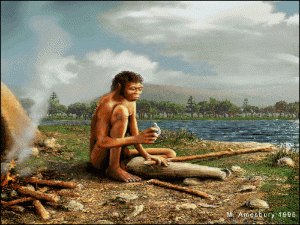PBS Documentary-Becoming Human Part 2 Review

In part two of Becoming Human, NOVA/PBS started to link us (Homo sapiens) to the common ancestor that we share with chimpanzees. That “link” (although I hate the word) is Homo erectus which lived around two million years ago up to having a few isolated tribes around in Asia as close to 50,000 years ago. Homo erectus was a tool maker, first to have socialized groups, user of fire and the first of us (members of the genus Homo) leave the Great Rift of Valley of Africa and follow their prey as the grasslands of Africa started to shift to Asia and Europe.
Their exploration looked into the discovery of the Turkana Boy, which fossilized skeleton was mostly preserved (due to that it died in water and there was preserved from carnivores). They discovered the age of Turkana Boy was 8 and he was an astounding 5’3’’. This high rate of growth early in development closely resembles that of apes. NOVA explored why today’s Homo sapiens develop much more slowly. It’s important to remember that our brain (1300 cc) is much larger than that of Homo erectus. Now, our brains development occurs mostly outside the womb (because if our heads were too big, we would be unlikely to be born for obvious reasons), therefore an increase childhood gives us more time for our brains to develop and thus explaining why Homo sapiens development is much slower than that of Homo erectus and chimps.
Although, Homo erectus brain is much smaller than ours, it is still almost double that of the common ancestor and chimps. With increase brain size (which takes up to 25% of the total body’s energy) comes a need for increase calories. This increase the selection to eat more meat and marrow which is high in calories and protein. It’s important to remember unlike us, Homo erectus was not at the top of the food chain, they were neither fast nor strong, which made them poor predators. Unlike their relatives they were hairless and had the ability to sweat, therefore giving them an advantage in endurance races with predators and with the development of tools also gave them an advantage. So, like today’s bushman, they would run the prey down over a long distance (up to 4 hours) until it would be completely exhausted (due to inability to cool itself) and then kill it with spears (short range tools anyway). This made them efficient hunters but they were in as much danger to get eaten as that prey was.
They also talked about why, when, and who were the first to leave Africa (Homo erectus) and why they were so successful (social communities, helping each other out), which could bring the answer to the origin of morality.
The final episode will air next Tuesday (11/17) at 8 p.m. on PBS and is entitled; Last Human Standing.

Leave a comment